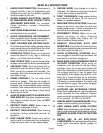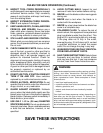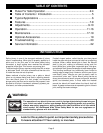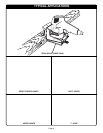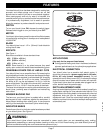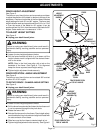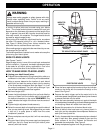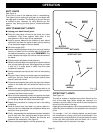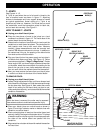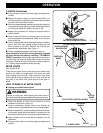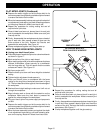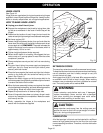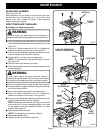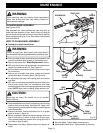
Page 11
1
2
3
1
2
3
OPERATION
Fig. 8
Fig. 7
■ Place the fence against the board and align the indicator
marks on the fence with the centerline mark(s) on the
board.
See Figure 7.
■ Depress the switch trigger and let the motor build to its
maximum speed, then gradually push biscuit joiner forward
to extend the blade into the wood.
■ When the base assembly bottoms out against the depth
of cut adjustment knob setting, pull back releasing pressure
on the spring. Blade will retract from biscuit slot.
■ Repeat this procedure for all desired biscuit slots.
■ Once all biscuit slots have been cut, place a biscuit in
each joint and dry assemble the workpieces. Make sure
each joint lines up and fits.
■ Finally, disassemble the workpieces and place a bead of
glue in each slot. Also, spread a bead of glue over the
entire surface of the joint. Reinsert the biscuits and
assemble the workpieces.
See Figure 8.
■ Clamp workpieces together until the glue sets up.
WARNING:
Always wear safety goggles or safety glasses with side
shields when operating tools. Failure to do so could
result in objects being thrown into your eyes, resulting in
possible serious injury.
A variety of spline joints can be made using your biscuit
joiner. The number and size biscuits needed for each joint
depends on the thickness of the wood and the length of the
joint. In general, the small #R1 biscuits should be used for
miter cuts in small, thin materials. The larger biscuits should
be used for edge-to-edge joinery.
When joining thick materials, stack two biscuits, one above
the other. For example, joining 2 in. x 4 in. dressed lumber.
See Figure 9.
When joining even thicker materials, use
additional biscuits, stacked above each other.
When making edge-to-edge joints the more biscuits you use,
the stronger the joint will be.
The following sections illustrate how to make various spline
joints using your biscuit joiner.
EDGE-TO-EDGE JOINTS
See Figures 7 and 8.
Edge-to-edge joinery is one of the most basic and easiest
joints to construct. In general, two basic adjustments have
to be made for all biscuit joinery applications. One is the
depth of cut and the other is the location of the cut.
HOW TO MAKE EDGE-TO-EDGE JOINTS
■ Unplug your detail biscuit joiner.
■ Prepare the workpieces by laying them side by side on a
workbench in the order in which they will be assembled.
■ Using a square, determine the location of each biscuit
spline joint and mark the center of each joint by drawing
a line across each workpiece. Mark the edges 1 in. from
the ends of workpieces. The joint will be stronger if you
use multiple biscuits placed close together.
■ Set fence angle at 90°.
■ Loosen height adjustment knobs, then pull and slide the
fence up or down until the indicator point is aligned with
the desired dimension on the scale. REMEMBER: The
scale indicates the height of the fence from the center of
blade.
■ Tighten height adjustment knobs securely.
■ Select the correct depth of cut setting to match the biscuit
size you are planning to use. We suggest that you make
a test cut in a scrap piece of wood from the same
workpiece if possible.
■ Clamp workpiece securely so that it will not move during
the cut.
■ Plug your biscuit joiner into power supply and prepare to
make your first cut. Grasp and hold your biscuit joiner
securely with both hands.
EDGE-TO-EDGE JOINTS
CENTERLINE
MARKS
BISCUIT(S)
BISCUIT SLOT(S)
TOP VIEW OF DETAIL BISCUIT JOINER
LINE OF
CUT WINDOW
INDICATOR
MARK(S)
CENTERLINE
MARK(S)



